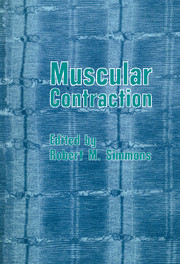Book contents
- Frontmatter
- Contents
- Dedication
- Contributors
- Preface
- 1 A. F. Huxley: an essay on his personality and his work on nerve physiology
- 2 A. F. Huxley's research on muscle
- 3 Ultraslow, slow, intermediate, and fast inactivation of human sodium channels
- 4 The structure of the triad: local stimulation experiments then and now
- 5 The calcium-induced calcium release mechanism in skeletal muscle and its modification by drugs
- 6 Hypodynamic tension changes in the frog heart
- 7 Regulation of contractile proteins in heart muscle
- 8 Differential activation of myofibrils during fatigue in twitch skeletal muscle fibres of the frog
- 9 High-speed digital imaging microscopy of isolated muscle cells
- 10 Inotropic mechanism of myocardium
- 11 Regulation of muscle contraction: dual role of calcium and cross-bridges.
- 12 Fibre types in Xenopus muscle and their functional properties.
- 13 An electron microscopist's role in experiments on isolated muscle fibres.
- 14 Structural changes accompanying mechanical events in muscle contraction.
- 15 Mechano-chemistry of negatively strained cross-bridges in skeletal muscle.
- 16 Force response in steady lengthening of active single muscle fibres.
- References
- Index
4 - The structure of the triad: local stimulation experiments then and now
Published online by Cambridge University Press: 07 September 2010
- Frontmatter
- Contents
- Dedication
- Contributors
- Preface
- 1 A. F. Huxley: an essay on his personality and his work on nerve physiology
- 2 A. F. Huxley's research on muscle
- 3 Ultraslow, slow, intermediate, and fast inactivation of human sodium channels
- 4 The structure of the triad: local stimulation experiments then and now
- 5 The calcium-induced calcium release mechanism in skeletal muscle and its modification by drugs
- 6 Hypodynamic tension changes in the frog heart
- 7 Regulation of contractile proteins in heart muscle
- 8 Differential activation of myofibrils during fatigue in twitch skeletal muscle fibres of the frog
- 9 High-speed digital imaging microscopy of isolated muscle cells
- 10 Inotropic mechanism of myocardium
- 11 Regulation of muscle contraction: dual role of calcium and cross-bridges.
- 12 Fibre types in Xenopus muscle and their functional properties.
- 13 An electron microscopist's role in experiments on isolated muscle fibres.
- 14 Structural changes accompanying mechanical events in muscle contraction.
- 15 Mechano-chemistry of negatively strained cross-bridges in skeletal muscle.
- 16 Force response in steady lengthening of active single muscle fibres.
- References
- Index
Summary
Introduction
Clay and I were both finishing a period of training at the National Institutes of Health in 1964, and we wanted to go to a laboratory that was attractive to both of us. With some apprehension, and a good deal of awe, we wrote to Professor Huxley. We were surprised and delighted when a very kind reply came back. We thus came to London for a period of two years, at a time when muscle research was very exciting indeed. Fred Julian was finishing his term there, and Hugo Gonzáles-Serratos was doing his “wavy fibrils” experiments.
Clay worked downstairs, initially on crab muscle and later on length-clamp experiments, and I worked upstairs, sharing the electron microscope with Lucy Brown. I was given the task of bringing crustacean muscle in line with the sliding-filament model. As Prof (as he was called) well knew, crustacean muscles offered all sorts of possibilities to the morphologist. Bob Eisenberg showed us how to dissect crab fibres. With Prof's advice and with friendly help and encouragement from Sally Page, these turned out to be very interesting. Prof was always happy to transfer some of his knowledge of optics, and several times suggested ingenious tricks to solve questions of magnification.
- Type
- Chapter
- Information
- Muscular Contraction , pp. 53 - 66Publisher: Cambridge University PressPrint publication year: 1992



